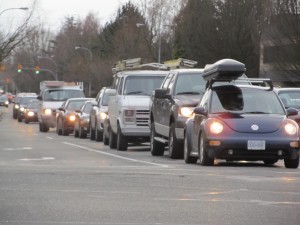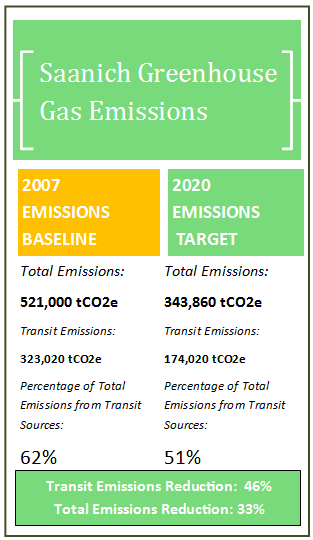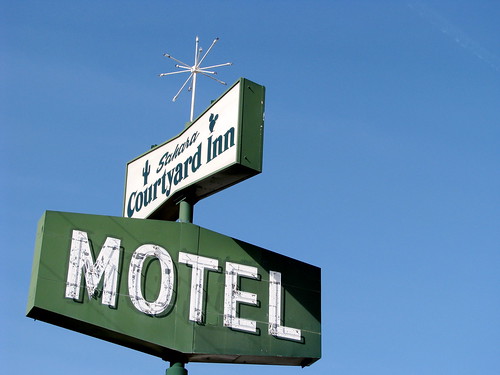By Steven Jones
VICTORIA – Families living in Gordon Head can expect three things from the corner of Shelbourne and McKenzie: gridlock, frustration, and long waits. The gloom of the daily traffic jam hangs over the intersection and good drivers take shortcuts and make errors trying to avoid getting stuck. The buses seem like they run on Soviet time, and most bike commuters approach the intersection like it’s the old Berlin wall. But for Dean Murdock, 30, second-term councillor with the Municipality of Saanich, Shelbourne and McKenzie represents an opportunity for change.
Traffic stands in the way of the city meeting climate change targets, is one of the major barriers to growth, and causes budget problems. The number of cars on the road, especially during rush hour, is a major driver of greenhouse gas emissions. Traffic congestion prevents smart development and densification by driving away investment, and without new construction, Saanich’s budget picture suffers. Murdock favours civic policies that he hopes will deal with all three problems at the same time, and sees Saanich benefiting in the future from the decisions made to deal with today’s problems.

Northbound traffic lines up at the intersection of Shelbourne St. and McKenzie Ave on February 28th, 2012.
“If transit can get a time advantage over the automobile, I think you’d see a major shift in commuter choices,” says Murdock. Murdock wants to see rapid transit deployed across Saanich’s major arteries, such as Shelbourne St. and McKenzie Ave. High-Occupancy Vehicle lanes, dedicated bus lanes, bike lanes and even light rail are all options, though he cautions that light rail is a distant possibility. He favours rapid transit infrastructure not just to save a few minutes on the morning commute, but for the benefits it will bring to the community. Less grid-lock means residents have easier access to major commercial centres, such as at Shelbourne and McKenzie, which makes these centers more attractive to businesses. Better traffic flow means fewer accidents, fewer injuries, and fewer police and fire department costs. It also means fewer hours that cars spend idling, waiting for traffic to inch forward.

Saanich seeks a 33% reduction in total emissions by 2020. Source: District of Saanich Climate Action Plan
“62 per cent of our greenhouse gas emissions are transportation related, and so that means obviously, we need to choose alternatives. The single-occupant vehicle is not doing us any favours when it comes to greenhouse gas emissions,” says Murdock. In its climate change action plan, Saanich has committed to a 33 percent community reduction in greenhouse gas emissions by 2020, and a reduction of 46 percent in fuel-related emissions, so every hour a car is parked is an hour of emissions the city does not have to account for somewhere else. Murdock sees better transit options as way to meet those reduction targets, while also improving the lifestyle of both current and future Saanich residents.
“Every area in Saanich suffers from traffic congestion. There isn’t an area of Saanich that isn’t congested, at least during peak hours and probably all day,” says Murdock. Saanich is the region’s largest municipality, and it now finds itself in competition for new residents with rapidly growing Westshore communities. In the 2011 census data, the district of Langford recorded a 30.1% growth rate over a five-year period, gaining almost 7,000 residents. In contrast, Saanich’s growth rate was just 1.4%, gaining 1487 residents in the same period.
“One of the greatest drivers in our community for revenue purposes in Saanich is development,” says Murdock. “One of the things that will frustrate that development is congestion on major corridors. People know; they don’t want to buy a house or a townhouse or a condo in an area where they can’t get out.” Murdock is not an advocate of growth at all costs. Instead, he sees smart growth, through improved density, transit options, and better planning, as the keys to solving current transit problems, and preventing new ones. He also sees smart growth as antidotes to the problem of slumping revenues in an age of a global economic downturn.

Census data shows dramatic changes in the Capital Region
“Builders aren’t going to build a place in Saanich if their customers or future buyers don’t want to live there,” says Murdock. Without a fix to the transit problem, developers will build in the Westshore, where congestion is not as severe as in some parts of Saanich. This could leave the city stagnant, both in terms of population and revenue. During a recession, businesses often cease to invest in new and existing properties, and city revenues dry up. While new civic infrastructure such as major public works may become difficult to justify, it can also threaten the maintenance of existing public works like sewers, roads, public parks, and recreation facilities, as city councils are forced to make cuts to match reduced tax receipts. That sort of long slide into disrepair is a future that Murdock would like to avoid.
“We can’t neglect the changes that do need to be made, because it’s going to frustrate any attempt at economic recovery if we have barriers to economic growth,” says Murdock. Instead, Murdock envisions making investments now, and anticipating future growth to guide those developments. The payoff for those investments will not be immediate, but could help Saanich stay relevant and attractive to its residents.
The intersection at Shelbourne and McKenzie is not yet free of congestion, and rapid transit lines are still a few years away. It may still suffer under the weight of an overloaded traffic system. But Murdock is still proud of Saanich as his community, and his role in it. Amidst the pall of the recession, he feels that sometimes people forget the nature of the city they live in.
“I think that we need to celebrate the fact that things are pretty good, and even in the period of global economic turbulence and in some cases recession, we’re still faring reasonably well,” says Murdock. He is hopeful. He sees what Saanich can become, if the right changes are made.
“But we can’t wait too long, or we’re going to lose the opportunity,” says Murdock.
-30-
Steven Jones is a freelance journalist living in Victoria, B.C.
Further resources:




